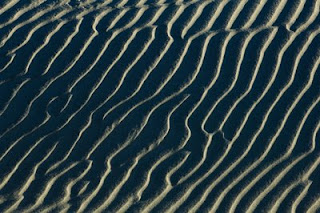PATTERNS AND TEXTURES

PATTERNS AND TEXTURES -When an object stands alone it can look unexciting. Add two identical objects and you begin to form a visually interesting pattern. The more you add the more complex and exciting the pattern becomes. Patterns and textures can be found all around us. You only have to look at the bee's honeycomb to realize that nature is a key supplier of these stimulating subjects. Look beyond the obvious in a landscape and you'll find patterns bursting out all over the place. The rolling hills, intruding fences and tree lined horizons all mix together to form spectacular patterns. The way the pattern falls determines how the eye scans the picture; vertical lines draw the eye upwards and horizontal across the picture. Use this to your advantage in drawing the eye to the key element of the photograph. Horizontal lines also offer a sense of calmness, while diagonal lines give a dynamic feel of movement. Altering your viewpoint can make a world of difference. Shoot a forest of trees from a hilltop and you'll create a patchwork of green. Move into the heart of the woodland and the trunks will make bold and dominating lines running up through the picture. Go in close and capture the texture of the tree's bark. Shoot upwards and you can concentrate on the texture of leaves. You only have to cut open an orange or a grapefruit to see a colorful display of patterns itching to be photographed. Look at the outside of a pineapple, the skin of a strawberry, the flesh of a kiwi fruit or the scales of a fish, they've all got something to offer. Look for: textures in decaying leaves, flaking paint, blades of grass, wooden fences, stone walls, spiders webs - the list is endless. Go out and about shoot mud cracks, patterns in sand, crazy paving, ripples in water, roof tiles, fields, etc. There are good patterns the seaweed and kelp create in the ocean water.
Useful tips. Look for subjects with lots of repetition, but don't rely on regular shapes or the picture may become boring. Keep the composition simple and exclude anything that may break the pattern. Pick out the most interesting parts of the scene and move in close cropping out distracting backgrounds.Zoom lenses are extremely useful for selective cropping of the image - some have macro or close-up settings and allow you to move in really close for smaller detail. A telephoto lens can be used to tighten perspective but have a tripod handy.Strong sunlight mixed with bright colors makes bold patterns whereas textures appear at there best when the lighting is subtle.To emphasize texture dramatically make sure the light source is coming from one side to cast raking shadows and give a feeling of depth. Shoot while the sun is low, early morning or late afternoon, for the best effects. Look for contrasting colors such as blue and yellow. They can help define patterns and shapes. Keith Skelton Photos



Comments
Post a Comment